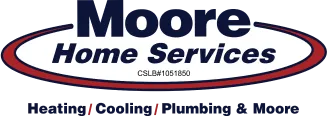Can you Purify Tap Water at Home?
Posted by Moore Home Services
Plumbing
The water coming into your home from a public reservoir should be safe, clean, and contaminate-free. Unfortuantely, this is not the case for some homeowners. There are also a percentage of homeowners—nearly half—who purify and filter water just because they like the taste better.
Keep in mind, that there is no easy way to completely purify tap water at home. However, we can filter your water so it’s clean and healthy.
Just a Pitcher Isn’t Enough
As we mentioned in the intro, a majority of people want to purify their water for taste alone. The reason they want to do this is because California water is notoriously hard. What we mean by hard water is that tap water can have trace amounts of calcium and magnesium, which make it hard. Hard water can damage your pipes and appliances. It can also leave a white residue on your dishes.
Another reason people want to purify their water is because most cities use chlorine to keep their public water supply clean. While the chlorine wont’ harm you, it’s not something everyone wants in their drinking water. Most Californians opt for a filtration pitcher. Or another receptacle with a built in water filter.
While a pitcher is great for a glass of water or refilling your pet’s bowl, it doesn’t work for the water you cook and clean with. Here are some of our favorite options.
Sink Filter Pros and Cons
In some homes, a sink filter is all you need. This is especially true for homes without a dishwasher. A sink filter is great if you want soft water for drinking, cleaning dishes, and cooking. However, its effectiveness ends there.
We understand why most people prefer a sink filter. They’re inexpensive, easy to install, and very easy to maintain. Just change the inner filter every 2-3 months.
Despite this, there are a few drawbacks. First, the sink filter only filters water that’s coming through that exact tap. It won’t filter the water in your shower or water going to your appliances. For those with a dishwasher, your clean dishes will still have the hard water marks on them. A sink filter will help if you hand wash.
Other Tried and True Water Filtration Methods
We recognize not everyone wants a sink filter, that’s why we have a few whole home water filtration options.
Water Softener
As the name implies, water softeners take the hardness out of your tap water. They use a saline solution to remove mineral deposits from hard water.
Pros: We’ve mentioned that hard water can make your dishes look bad, but think of what they’re doing to your appliances. Not even the coffee maker is safe. A water softener helps elongate the lifespan of your appliances and helps keep them clean.
Softer water also helps you clean your home, and yourself, easier. Homeowners say they use less shampoo, conditioner, and soap in the shower when their water is soft.
Cons: Perhaps the biggest drawbacks of a water softener are cost and maintenance. In addition to installation costs, you’ll need to buy salt for the water softener and refill the salt once every month.
Along with the salt comes environmental issues as well. When dumped, salt wastewater can pollute freshwater streams and lakes. Also, water softeners do not purify or disinfect water. They only help with the taste and smell of tap water.
Reverse Osmosis
Reverse osmosis is a common water filtering technique that is popular with San Diego homeowners. Notice, we said filtering, not purification. Reverse osmosis is a style of filtration. It works by pushing water through a “semi-permeable membrane.” This membrane is fine enough that it can catch microscopic contaminates from your drinking water.
During the reverse osmosis process, water is pushed through a series of filters and then deposited into a holding tank. The holding tank is where clean, filtered water is stored until you turn on a tap.
Pros: Reverse osmosis has several benefits. One of our favorites is that reverse osmosis filters out more contaminates than a water softener. Also, because of the way the osmosis system works, it can purify the water you use for cooking and cleaning. Which leaves everything a bit fresher and cleaner.
Cons: However, just like everything else, there are a few drawbacks. Just like a water softener system, wastewater created by reverse osmosis can have lasting effects on the local ecosystem. There is also a noticeable drop in water pressure after a reverse osmosis system is installed.
Consider a Whole House Water Filter
There is one more method to filter and purify tap water at home and that’s a whole house water filter.
A whole house water filter system filters any water before it actually comes into your house. Meaning the water is clean and filtered before it goes through any of your faucets. With a whole house filter, you can enjoy filtered water in your shower, dishwasher, and clothing washer.
And unlike water softeners or osmosis systems, there is no maintenance required. The biggest drawback is cost. Whole house water filters can be quite expensive, so you’ll need to decide if it’s the right choice for your home.
To learn more about available water filtration and purification solutions, contact the experts at Moore Home Services.


